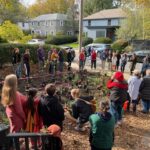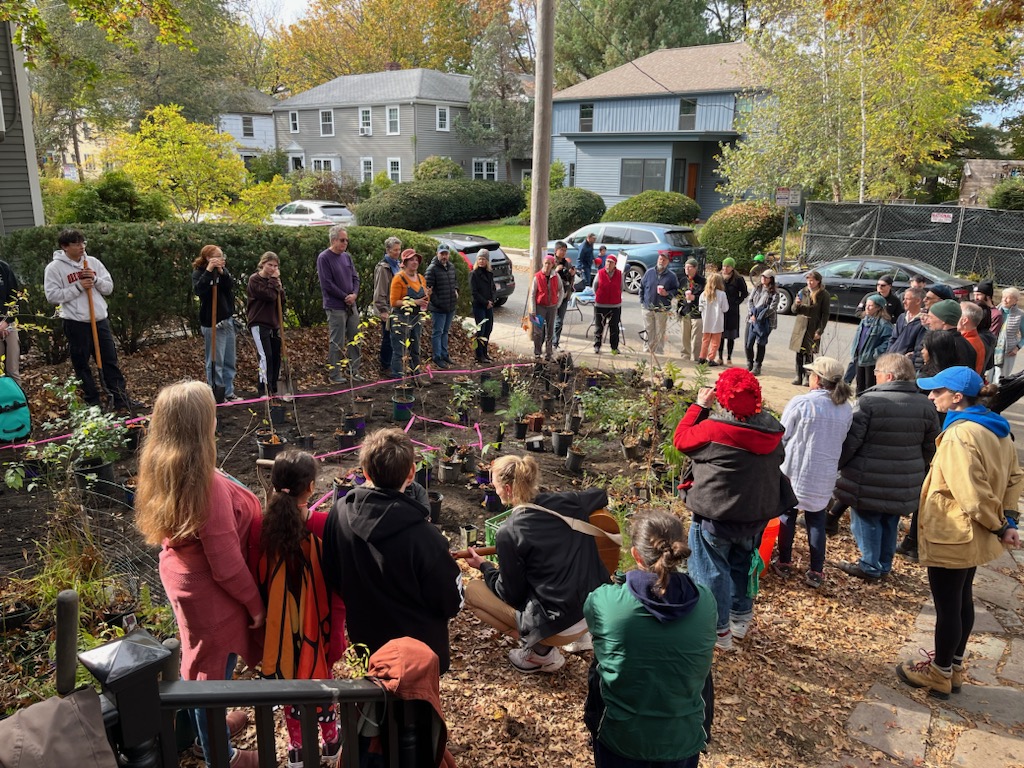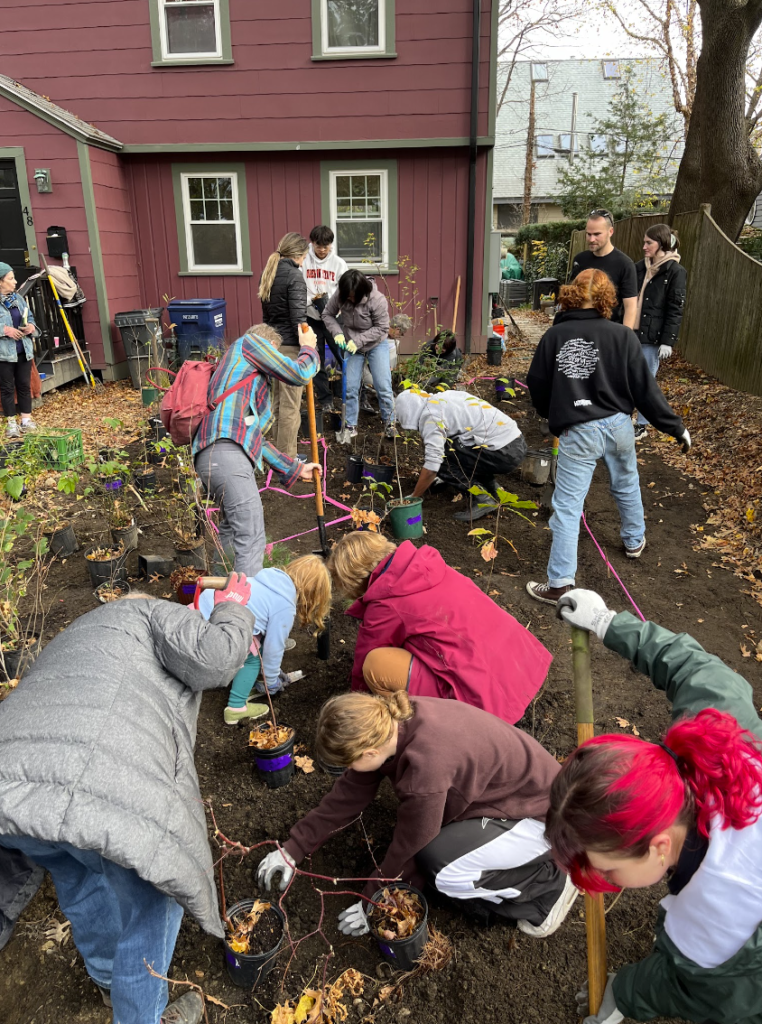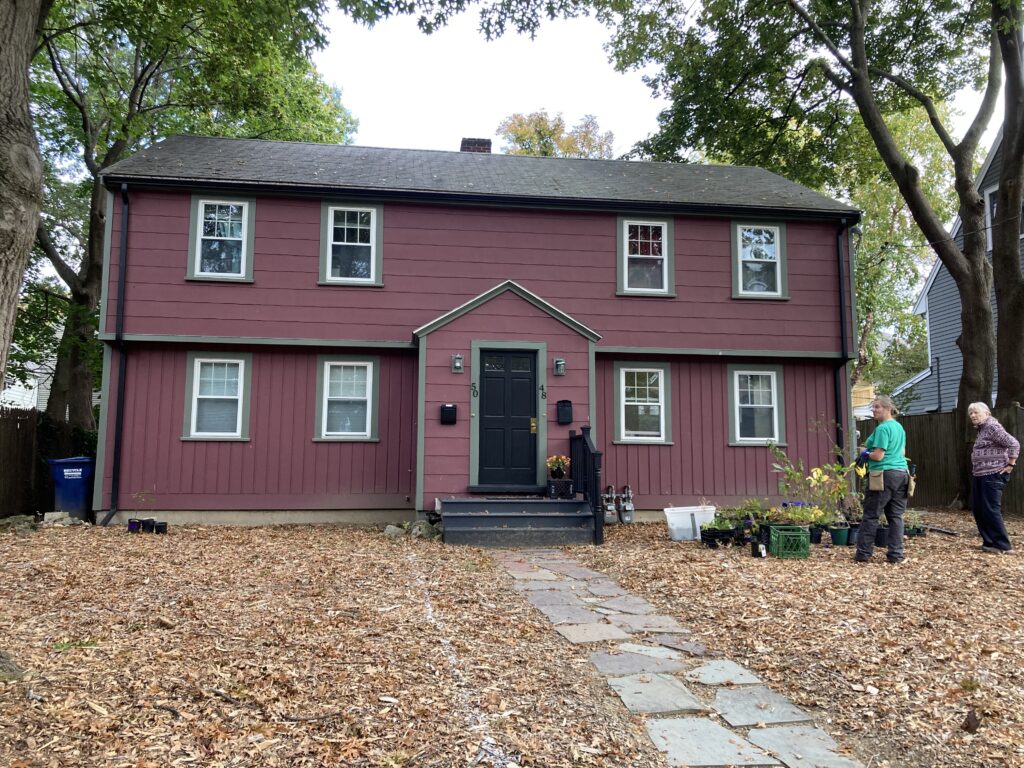
An abridged version of the article appeared in the July/August 2024 BCF Newsletter.
Group Plants Front-Yard Forest in Cambridge
By Susan Filene, Tori Antonino, Judy Perlman, and Ali Kruger
The first Miyawaki forest in the northeast was planted on public land in Cambridge in September 2021. (Miyawaki Forest Boosts Biodiversity, Resilience, BCF Newsletter, May 2022). Similar little forests have been planted or are planned for nearby communities, including Somerville, Brookline, Watertown, Natick, and Worcester.
It occurred to me that people could do something similar, on a smaller scale, in their urban/suburban yards. We could replace lawns with native species of trees, shrubs, and groundcovers which would have the same positive effects as a larger Miyawaki forest—carbon sequestration, soil improvement, pollinator food, stormwater management, and local cooling. My husband and I had a lawn in front of a two-family house we owned on Alpine Street in Cambridge, and we decided to see what could be done to replace it.
Not knowing where to begin, I searched on NextDoor for someone who did. Tori Antonino, owner of Victorious Gardens, responded, “That is what I do, turn lawns into meadows or, even better, Miyawaki forests.” Exactly the person I needed.
Tori came to see the site. It was late summer of 2022. Her advice was to let all of the leaves from an existing large oak and from neighbors’ Norway maples lie where they would fall come autumn. That was all there was to do until spring.
Tori returned to the site in the spring to examine light, slope, and water runoff so that she could plan which native plants would do well. She ordered a truckload of wood chips to cover the entire area for the summer to smother the grass. Tori and I brought in Judy Perlman and Ali Kruger, two women who lived in apartments overlooking the lawn. They would see the forest every day and needed to be part of the project. By the conclusion of the forest project, we had formed the Alpine Street Forest Group with a goal of encouraging, advising, educating, and enabling others to plant native species on their own properties.
Tori went to a spring sale of native plants and bought the first vanload. She set up a nursery in a shady backyard corner where those first plants would stay over the summer until the fall planting.
Meanwhile, there was a lot of work to do at the site: testing soil, contacting DigSafe, sourcing mulch, bringing in hundreds more plants, and arranging for a site visit by Walter Kittredge, to get his opinion about what more was needed. Kittredge spent his career as a taxonomist Harvard University’s Gray Herbariaum, and now runs a native plant nursery called Oakhaven Sanctuary. We learned much more was needed because, when Walter stuck his shovel into the ground to examine the soil, the shovel went in about one inch and no further.
We had hardened clay for soil. A rototiller would break before loosening the soil, and the site did not lend itself to using a backhoe. The entire yard had to be turned by hand using pickaxes, garden spades, and shovels. We had to find a lot of people to help get the ground ready for planting in the short window of time remaining before planting day.
We put out a call for volunteers through local listservs. People responded with interest in preparing the site and joining community planting days. The work took place over many days. Some people came every day, some for a couple of hours. People worked, rested, chatted, and worked some more until the soil had been loosened to at least a foot deep.
The next step, according to Miyawaki guidelines, was to incorporate quality mulch into the loosened soil. Volunteers returned to fork in the mulch. Tori brought in more than 100 native plants, including red maple, grey birch, chestnut oak, and over a dozen tree species.
With the site prepared, the forest group sent invitations across the city and beyond for people to join planting day, November 4, 2023, as a celebration of community and nature. Ali gathered petitions from neighbors to close the street for a fair. The city of Cambridge brought street games for kids and provided $200 to spend on whatever the forest group thought would add joy to the day. Conservation groups, Belmont Acres Farm, and Cambridge chicken keepers set up displays.
More than 200 people of all ages stopped by for many reasons—to plant trees, to learn about native species, to meet new neighbors, to see old friends; to spend all day or an hour enjoying music, food, and face painting. The joyous energy emitted by so many people may have contributed to the fact that now, seven months later, the mini-forest is thriving.
There are differences between this little forest and the Miyawaki forests which have been planted in this area so far. Alpine Street Forest is on residential property, which meant there were things to take into account which anyone planting on public land does not have to consider. We couldn’t dig deeply where there were underground utility lines. The area was shaded by an existing tree and by neighbors’ trees and, for part of the day, by the house on the property and neighboring houses. An oak with massive roots limited digging in one area. Downspout runoff and discharge from a sump pump created a permanent boggy area.
Tori turned these limitations into features. An area where they couldn’t dig deeply became a little meadow with sedges, wild strawberries, and a seating area. Tufted hair grass and path rushes and spring ephemeral flowers including Jacob’s ladder and Virginia bluebells went in over the utility lines. Tori made a little dip in the boggy area to form a vernal pool and planted pussy willow, marsh marigold, and other plants which like their feet to be wet.
Judy and Ali will be seeing the forest every day. It had to be pleasing to them. Ali’s daughter wanted to be able to play in, rather than near, the forest. Tori incorporated a winding “trail” through it, and everyone is surprised by how much the kids are using it to interact with the plants. The plants will need a bit of pruning now and then, as they would along any forest trail.
Another difference between the Alpine Street Forest and the formal Miyawaki forests is that the soil at Alpine was loosened to one foot rather than the two feet advised by Miyawaki. Roots should be able to penetrate where pickaxes and garden forks could not.
The Alpine Street Forest also contains herbaceous perennials which a “true” Miyawaki forest lacks. These plants provide essential habitat for pollinators and other beneficial insects.
Why change a lawn into a mini-forest or into an area of native plants?
Little forests and dense native plantings improve soil and air quality, provide food and homes for pollinators and small animals, help to ameliorate climate change impacts, and make life better for humans.
Every part of the little forest helps to improve soil biome. The biome of healthy soil is a neighborhood of dead and dying carbonaceous material and living bustling bacteria, fungi, tiny bugs, earthworms, and the roots of a variety of plants. Every part of the whole is necessary for the health of the other parts. When the plants are native to the conditions of their environment, they foster the biome which supports their particular needs. When plants are not native, the inputs needed to keep them thriving is detrimental to the creatures living below the soil as well as those living above.
One of the worst things people do to soil biome is to install lawns. Lawns have no means of adding deep healthy roots below and, therefore, no means above the soil of turning carbon into sugars to feed creatures below the surface.
The mini-forest sequesters carbon. Trees and plants pull carbon from the air and turn it into some form of sugar. Much of that sugar is sent to the roots to be stored or exchanged for minerals in an underground barter system with the living organisms below. When a plant or a soil organism dies, the roots of the plant and the body of the organism remain in the soil forever if the soil is not disturbed, keeping the carbon sequestered in those roots and in the decomposing body.
The mini-forest manages stormwater. During the past year, the site has experienced many long, heavy rainstorms with water pouring not only onto the ground, but being discharged from French drains homeowners installed to keep basements from flooding. The forest manages water in several ways. As the rain falls, it will be intercepted by the canopy and break into smaller and smaller droplets as it falls down through layers of vegetation. Some will remain on leaves or needles to evaporate. Because the soil in the forest is permeable, water can be absorbed. Some absorbed water is taken up by roots into plants.
The mini-forest cools its area. Heat waves exacerbate health issues, especially cardiovascular and respiratory disease. They’re associated with increased hospital admissions, psychological stress, aggressive behavior, and excess mortality. Most heat- related deaths occur in urban areas. A study from Adelaide, Australia, found that trees could lower local surface temperatures up to nearly 11℉. The article referred to another study showing that tree canopies made of diverse species make surfaces cooler than less diverse canopies.
The mini-forest provides food and safe habitat for pollinators, birds, and small animals. Pollinator populations have decreased to the point that the human food supply is endangered. Application of insecticides and loss of species-specific food sources are reasons. These little forests can be designed with habitat and food needs of local pollinators and species in mind. If we encourage the planting of many small safe islands of native plants, we may be able to reverse the destruction of tiny life-giving creatures and provide for other species which are disappearing.
The mini-forest impacts human health in positive ways. In subtle but measurable ways, the mini-forest benefits human health. A 1982 study by Roger Ulrich showed that surgical patients assigned to rooms with windows looking out on nature had shorter post-op stays and took fewer pain medications than matched patients in rooms with windows facing a building wall. Why? Reducing stress, and therefore reducing stress hormones, allows for immune cells to increase and to function better.
This phenomenon can occur when looking at a picture of a natural setting, looking out a window at a natural setting, or actually being in a natural setting. The effect increases with increasing proximity to the natural setting. Trees and plants emit volatile compounds called phytoncides to protect themselves from harmful bacteria, fungi, and insects. When humans breathe in these phytoncides, stress hormones decrease and cells of the immune system increase.
The mini-forest fosters community and anchors us to place. Events involve many people such as the festivals of Planting Day and Winter Solstice Celebration at the forest, or one-on-one interactions with neighbors who stop to admire, ask a question, or just breathe in what the plants have to offer. People who interact with the forest are beginning to “own” it and to engage with it in ways that suit them.
Mission of the Alpine Street Forest Group
We formed the Alpine Street Forest Group to encourage, advise, and assist others, whether individuals, faith communities, or municipalities, to turn lawns or part of lawns into areas which will benefit soil, air, pollinators, and people by installing native plants. We have videos, articles, a webinar, or in-person presentations to share, and we welcome invitations.
We plan to work with local, state, and federal officials to find ways to encourage individual urban and suburban property owners to rewild their land. Federal and state tax credits similar to those used to encourage conversion to solar power, local tax abatements based on percentage of property rewilded, and targeted grants for materials and labor could have an impact on livability in our local cities and towns.
We will continue to document and to share news of the growth of the Alpine Street Forest and what we will be learning from it as it matures.
Our inspiration to do more comes in part from observing neighbors and people across the world as they join the ever-growing movement to reforest, rewild, regenerate, and restore native habitat. We see the city departments and organizations propagating opportunities for public participation in supporting green space, including Green and Open Somerville, the Massachusetts Pollinators Network, and SUGi, among too many to name!
Perhaps the most energizing aspect for us is that you might take the steps within your power to support a thriving local ecosystem, whether you are just turning curiosity into action or expanding upon what you already do. If you would like to explore ideas for how to get started, we welcome your questions at alpinestreetforest@gmail.com.
Susan Filene is a Cambridge resident and cofounder of the Chilton Street Urban Farm. Tori Antonino a Somerville resident and a local activist, ecological landscaper, and guerrilla gardener. Judy Perlman is a Cambridge resident who works with government and nonprofit teams to advance housing stability. Ali Kruger is a Cambridge resident who fosters collaboration to bring new ideas into being.






Sorry, the comment form is closed at this time.